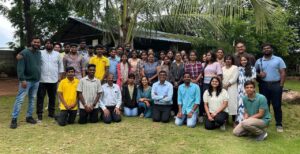Britain’s leading vaccinology center, the Pirbright Institute, is on the global front lines of preventing the spread of all manner of livestock diseases. Among them are various closely watched lab tests on pigs injected with African Swine Fever (ASF). This disease is leading to the culling, burning and burial of tens of millions of pigs across large swaths of Europe and Asia, particularly China, where the government is now tapping reserves to keep up with demand of the nation’s favorite meat; a vaccine or treatment would be a life-saver on a vast scale. But it has to be affordable.
The Institute has also been working for years to forestall periodic regional outbreaks of Foot and Mouth Disease Virus (FMDV).
(The Brits among you won’t forget the foot and mouth crisis of 2001 when 6 million sheep, cattle and pigs cows were killed to halt the disease resulting in billions of pounds worth of losses across industries.)
As with ASF, the affordability element has long been an issue for farmers also chasing slim profit margins, especially in the developing world. This month, however, Pirbright revealed a breakthrough that could save lives and minimise hassle: “a new, effective and affordable vaccine to protect livestock against several serotypes of FMDV.” The Institute, along with research partners, has granted MSD Animal Health an exclusive commercial licence for it.
An affordable vaccine for FMDV
According to the institute’s vaccinologists, the new vaccine is more stable than current foot-and-mouth disease (FMD) vaccines and is less reliant on a cold-chain during vaccine distribution – characteristics that give the vaccine greater potential for helping to relieve the burden placed on regions where the disease is endemic in Africa, the Middle East and Asia.
The vaccine has been developed from basic science to animal trials as a result of long-standing collaborations between Pirbright, the University of Oxford, Diamond Light Source, the University of Reading and MSD Animal Health, a division of Merck & Co., Inc — who will now be taking forward the new technology into development, registration and manufacturing. This work has been supported by funding from Wellcome to speed up commercialisation.
The holy grail of vaccines: safe, strong, stable, easy, affordable
The granting of the licence is described by a spokesperson at Pirbright as “an important milestone” in years of research led by Professor Bryan Charleston, director at Pirbright, Professor David Stuart, Life Sciences director at Diamond Light Source and MRC Professor in Structural Biology at the University of Oxford and Professor Ian Jones, University of Reading, to develop a new synthetic vaccine designed to trigger optimum immune responses without the need to grow live infectious virus for vaccine production. It also highlights the confidence MSD Animal Health has in the new vaccine’s effectiveness, safety and viability for commercial production.
According to a statement sent to AFN, the vaccine “is made of small synthetic protein shells, called ‘virus like particles’ (VLPs), which mimic the FMDV outer shell and so stimulate an immune response. Unlike other inactivated foot and mouth disease vaccines, the VLPs do not require high containment facilities for production and have been engineered to remain stable up to temperatures of 56°C, reducing reliance on cold-chain transport and storage. These two factors will revolutionise vaccine deployment in areas of Africa and Asia, where the disease continues to circulate.”
Potential for polio?
Regions where the disease is not endemic could also benefit; the VLPs lack specific viral proteins, facilitating differentiation between vaccinated and infected animals (DIVA) such that trade would not be hindered by a vaccination programme and this protection would eliminate the need for mass culling in the event of an outbreak.
Importantly, the scientists note, this method of making and stabilising vaccines could potentially be employed in the fight against other viruses from the same family, including polio.
FMD not only impacts animal welfare, but the wellbeing of those reliant on susceptible animals for produce and trade. This vaccine will help to address the current shortfall in vaccine availability, which will have a huge impact on the economic prosperity of those countries blighted by the disease, as well as improving the livelihoods of those living in affected regions.
Dr Charleston of the Pirbright believes his research now undergoing commercial development “will have a major impact on the health and wellbeing of those people whose livelihoods have been most severely affected by this devastating disease.” The vaccine’s properties, he said, “allow for a greater degree of flexibility during production, storage and transportation, which will result in a more affordable solution and therefore better access to those living in areas such as Asia and Africa.”
Dr Erwin van den Born, R&D project leader at MSD Animal Health, added in a statement that “Foot and mouth disease causes enormous economic losses to the livestock industry, resulting from morbidity in adult animals, reduced animal productivity, mortality in young stock and restriction to international trade in animals and animal products. We are pleased to be part of the solution in working with the research collaborators on new technology to quickly adapt vaccines to emerging viruses.”
Overcoming manufacturing challenges
Professor Jones, of the University of Reading, adds that many successful findings at the bench “fail to progress to commerce as their manufacture is problematic.”
“It is particularly gratifying,” Dr Jones notes, “that MSD Animal Health has engaged fully with our recombinant vaccine for foot-and-mouth disease. I look forward to seeing their industrial know-how catapult the product into the commercial arena to provide a cost effective and safe vaccine to the benefit of industrial and subsistence farmers alike.”
Professor David Stuart adds how his team has been working “to achieve something close to the holy grail of vaccines.”
Instead of traditional methods of vaccine development, he says, using infectious virus as its basis, “our team synthetically created empty protein shells to imitate the protein coat that forms the strong outer layer of the virus.”
He describes how Diamond’s visualisation capabilities and the expertise of Oxford University in structural analysis and computer simulation, which “enabled us to visualise in detail something invisible in a normal microscope and to enhance the design, atom by atom, of the empty shells. The key thing is that unlike the traditional FMDV vaccines, there is no chance that the empty shell vaccine could revert to an infectious form. The licence that has just been granted suggests that the work will have a broad and enduring impact on vaccine development.”




